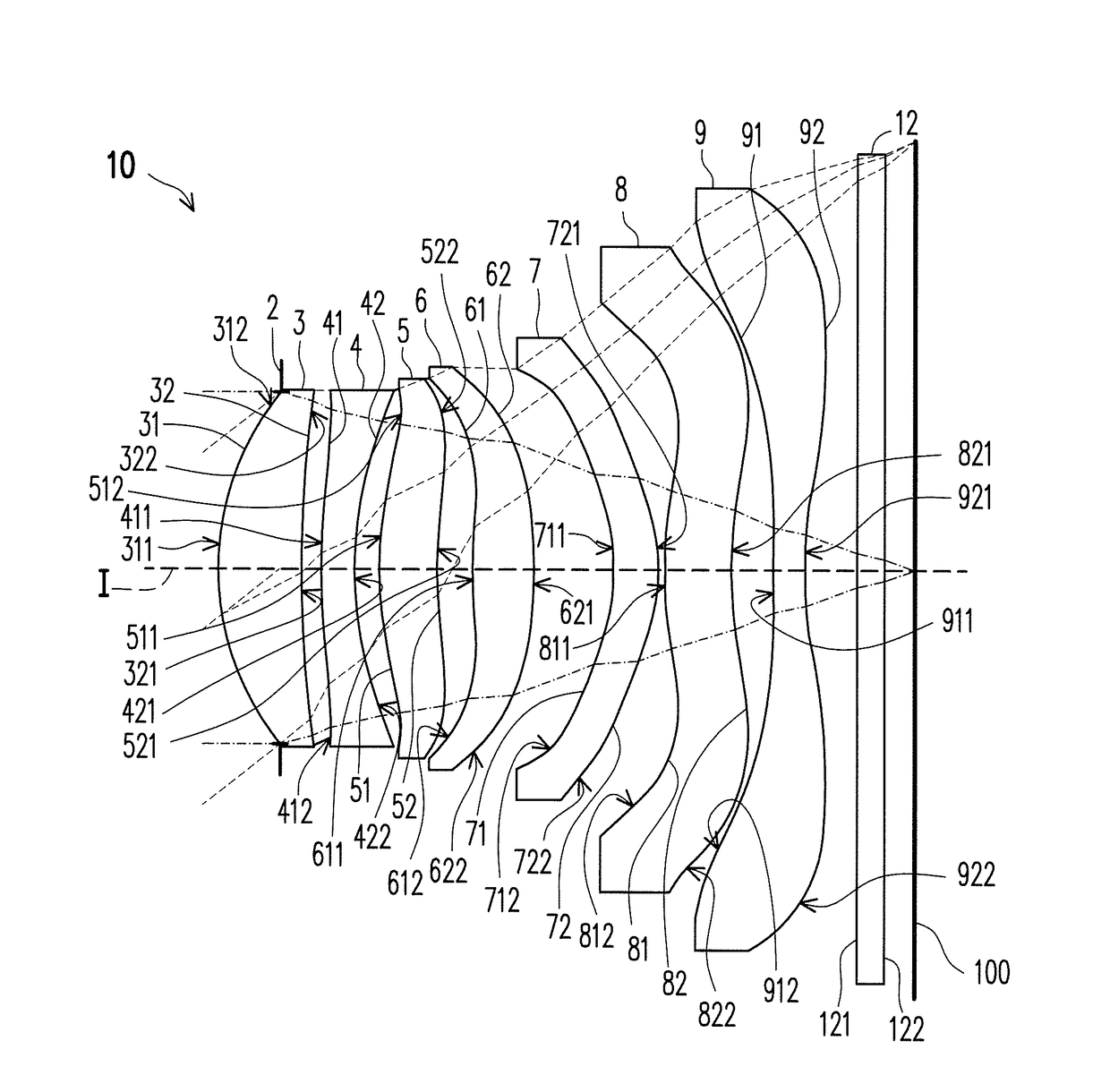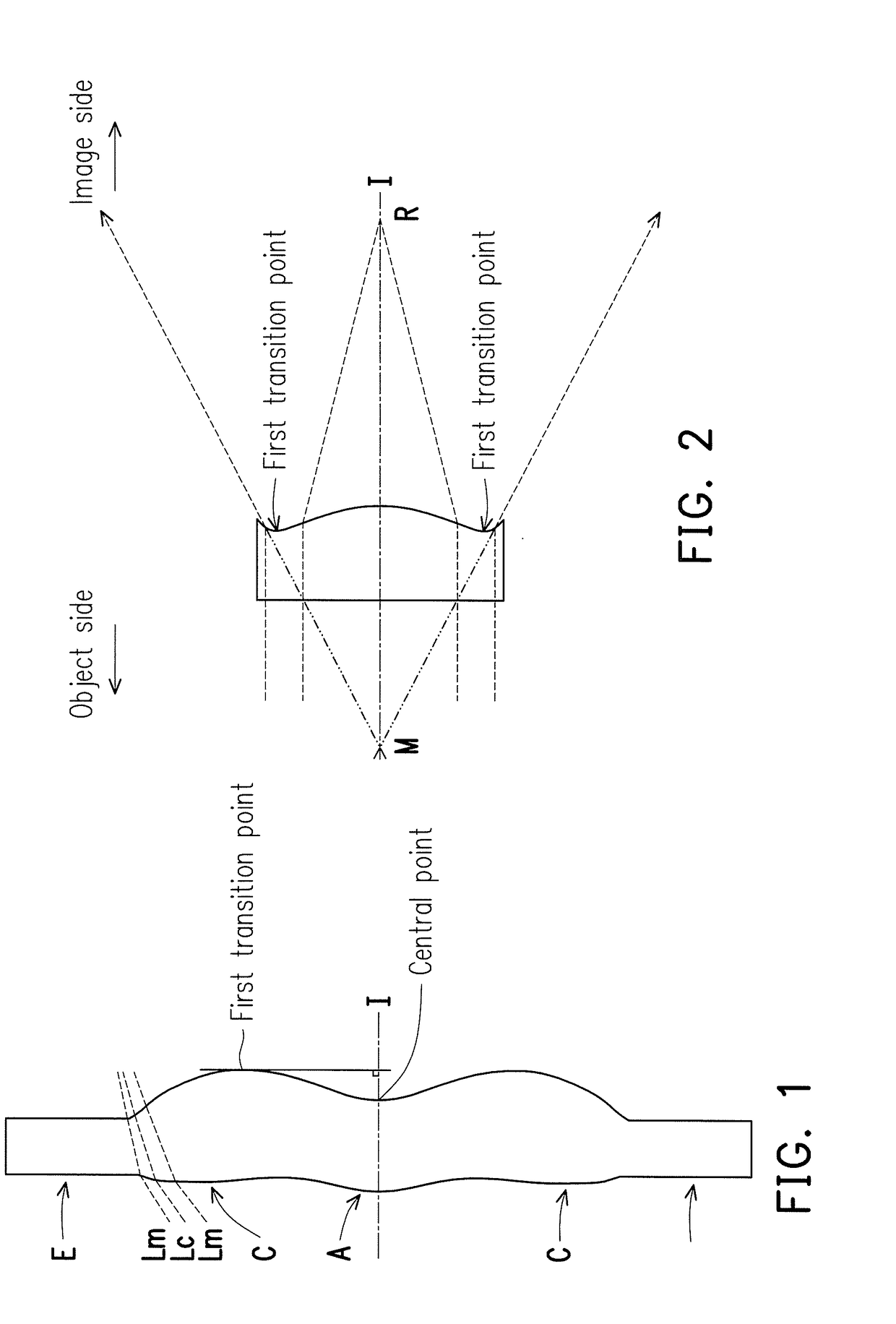Optical imaging lens
- Summary
- Abstract
- Description
- Claims
- Application Information
AI Technical Summary
Benefits of technology
Problems solved by technology
Method used
Image
Examples
first embodiment
[0089]The aspheric coefficients of the object-side surface 31 of the first lens element 3 through the image-side surface 92 of the seventh lens element 9 in the formula (1) are shown in FIG. 9. Wherein the column reference number 31 in FIG. 9 represents the aspheric coefficient of the object-side surface 31 of the first lens element 3 and so forth. In addition, the relations among important parameters pertaining to the optical imaging lens 10 in the first embodiment are shown in FIGS. 50 and 51.
[0090]Wherein:
[0091]EFL represents an effective focal length of the optical imaging lens 10;
[0092]T1 represents a thickness of the first lens element 3 along the optical axis I;
[0093]T2 represents a thickness of the second lens element 4 along the optical axis I;
[0094]T3 represents a thickness of the third lens element 5 along the optical axis I;
[0095]T4 represents a thickness of the fourth lens element 6 along the optical axis I;
[0096]T5 represents a thickness of the fifth lens element 7 alo...
second embodiment
[0138]The detailed optical data pertaining to the optical imaging lens 10 is shown in FIG. 12, and the effective focal length of the total system in the second embodiment is 4.195 mm, the HFOV thereof is 37.493°, the Fno thereof is 1.512, the system length thereof is 5.520 mm, and the image height is 3.325 mm.
[0139]FIG. 13 shows the aspheric coefficients used in the formula (1) of the object-side surface 31 of the first lens element 3 through the image-side surface 92 of the seventh lens element 9 in the second embodiment.
[0140]In addition, the relations among important parameters pertaining to the optical imaging lens 10 in the second embodiment are shown in FIGS. 50 and 51.
[0141]The longitudinal spherical aberration of the second embodiment shown in FIG. 11A is simulated in the condition that the pupil radius is 1.3982 mm. According to the longitudinal spherical aberration diagram of the second embodiment shown in FIG. 11A, a deviation of the imaging points of the off-axis rays of...
third embodiment
[0144]The detailed optical data pertaining to the optical imaging lens 10 is shown in FIG. 16, and the effective focal length of the total system in the third embodiment is 4.106 mm, the HFOV thereof is 37.700°, the Fno thereof is 1.516, the system length thereof is 5.660 mm, and the image height is 3.314 mm.
[0145]FIG. 17 shows the aspheric coefficients used in the formula (1) of the object-side surface 31 of the first lens element 3 through the image-side surface 92 of the seventh lens element 9 in the third embodiment.
[0146]In addition, the relations among important parameters pertaining to the optical imaging lens 10 in the third embodiment are shown in FIGS. 50 and 51.
[0147]The longitudinal spherical aberration of the third embodiment shown in FIG. 15A is simulated in the condition that the pupil radius is 1.3686 mm. According to the longitudinal spherical aberration diagram of the third embodiment shown in FIG. 15A, a deviation of the imaging points of the off-axis rays of diff...
PUM
 Login to View More
Login to View More Abstract
Description
Claims
Application Information
 Login to View More
Login to View More - R&D
- Intellectual Property
- Life Sciences
- Materials
- Tech Scout
- Unparalleled Data Quality
- Higher Quality Content
- 60% Fewer Hallucinations
Browse by: Latest US Patents, China's latest patents, Technical Efficacy Thesaurus, Application Domain, Technology Topic, Popular Technical Reports.
© 2025 PatSnap. All rights reserved.Legal|Privacy policy|Modern Slavery Act Transparency Statement|Sitemap|About US| Contact US: help@patsnap.com



